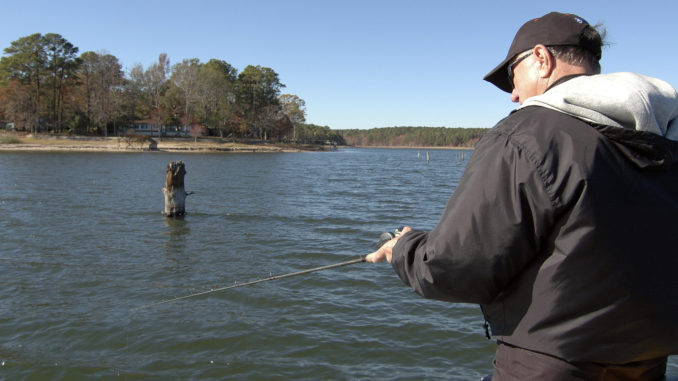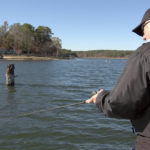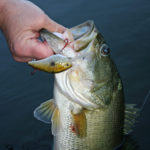
Just about anyway, anywhere you want
It’s too bad that so many guys who bass fish also like to deer hunt. There are only so many days in November, and the tree stand usually wins out over the bass boat.
It’s too bad because November is one of those months when just about any way you want to fish for bass will work. There will be some fish right on the bank, some in deep water, some in-between. There will be all kinds of stuff going on, and most of it will be good.
The best pattern for me is to fish shallow, close to deep water. I catch most of my fish in 10 feet of water or less. It’s similar to a late-winter pattern. I want to fish places where I’m sitting in my boat in 25 feet of water, throwing to the bank. That would have to be where a creek- or river-channel bend runs up against the bank.
Places like that become really good spots because as the water cools into the mid- to low-50s, a lot of bass will head for places where they can move quickly from deeper water to shallow water to feed — similar to the areas they’re in when the temperature is warming up into the low-50s in the late winter and early spring.
I like to fish a medium-running crankbait that will run down about 10 or 12 feet, because most of your fish will be at that depth or shallower. In November, shad are moving back out toward the main lake, and crankbaits in shad colors or patterns are good. I like brown/bone, gray ghost, black back/white sides, and it’s hard to beat pearl-gray shad day-in and day-out. The only thing you really need to do is figure out whether they want a bait with a hard wiggle like a Killer B or a different action.
What’s interesting is how patterns differ depending on what lakes you’re fishing. When you’re fishing one of the lakes on the Yadkin chain, with the exception of Badin, bass will stay shallow longer. At High Rock in November, you’re fishing shallow brush, docks and any shallow place with rock, because the fish are going to be 10 feet deep or shallower. But when you go to lakes on the Catawba and Roanoke systems, you’re likely to find them going deeper earlier. You’ll catch fish deeper on Wylie, Norman, Buggs Island and Gaston. They tend to go deeper earlier on lakes that are usually clearer. They get in their winter pattern earlier.
If one of those lakes is your home lake, you’re going to look for a main-lake pattern developing, because as bass move deeper, they’ll be moving out of the creeks. What I’m going to look for when it comes to deep, main-lake fish, is high spots right along the river channel. There have been some tremendous stringers caught on a jigging spoon 25 or 30 feet deep, and sometimes you’ll get on a bite where you find big bass, stripers and, at least at Gaston, walleye all together.
I like to jig with a ¾- or 1½-ounce Hopkins spoon. I like the heavier one, because it will get to the bottom faster. You can get right over top of the spot and jig vertically, or you can cast your spoon out a little bit and jig it back to the boat.
Some of the best days I’ve ever had on the water were on Lake Gaston in October and November back around 1990, jigging a spoon right along the river channel and catching big bass, big stripers and walleye in the same spot. What I found was that if you jig the spoon no more than a foot or so off the bottom, you’d catch bass and walleye. If you jigged it higher, you’d catch stripers. I think you can jig it anywhere from a foot to 2-1/2 feet off the bottom and catch fish.






Be the first to comment